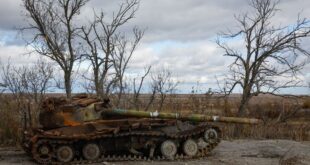BUCHAREST (Reuters) – Romania is moving air defences closer to its Danube villages across the river from Ukraine where Russian drones have been attacking grain facilities, and is adding more military observation posts and patrols to the area, two senior defence sources said.
The measures, along with the deployment of four additional U.S. F-16 fighter jets and an expanded no-fly zone, are a sign of growing concern in Romania and the broader NATO alliance that the Ukraine war could spill over into its territory.
In November last year, a missile hit southern Poland killing two people and prompting a brief security scare, although it was later determined that Ukrainian air defences were to blame. Now Romania is in the spotlight.
Soon after pulling out of the Black Sea grain deal on July 17, Moscow began targeting Ukrainian ports and warehouses along the Danube, in an apparent attempt to choke off the main alternative route for Ukraine’s agricultural exports.
Among the targets were the Ukrainian ports of Izmail and Reni, both of which lie across the Danube from Romanian soil.
Isolated incidents of drone parts landing in Romania underline the risk of a misunderstanding, or worse, between Russia and NATO, prompting Romanian armed forces to increase security in the area to protect civilians, the two sources said.
They declined to be named in order to discuss sensitive security matters.
The army has built two bomb shelters in the small hamlet of Plauru, just a few hundred metres from Izmail, and residents in the wider area are sent alerts on mobile phones when Russian drones are detected heading in their direction.
Tudor Cernega, mayor of the commune of Ceatalchioi which includes the hamlet of Plauru, said, however, that poor mobile reception there limited the effectiveness of the warnings.
In a statement last Friday Romania’s defence ministry said that around 100 U.S. troops and four U.S.-designed F-16 Fighting Falcon jets had arrived at Borcea military air base around 150 km south of Izmail.
From mid-September, the ministry also expanded a no-fly zone along a section of the border with Ukraine to up to 30 km (20 miles) inside Romania and to a height of 4,000 metres as a deterrent against Russian drones entering Romanian air space to reach enemy targets.
ROMANIA ‘NOT THE TARGET’
NATO Secretary General Jens Stoltenberg told reporters in Kyiv on Thursday there was no evidence that Russian strikes near the Ukraine-Romania border were a deliberate attack on Romania, but described them as “reckless” and “destabilising”.
Romanian defence ministry spokesman Constantin Spinu also said there was no indication Russia was targeting Romania, but that the nature of attacks on Ukrainian territory nearby made it virtually impossible to prevent all breaches.
“They (Russian drones) fly at very low altitudes, sometimes less than 200 metres (above ground) … they are built in such a way that least reflects radar waves,” he said.
“No country in the world can 100% protect its air space against all means of attack.”
The defence sources said they did not know of any instance where fully functioning Russian drones had entered Romanian air space, and that the three known cases of drones or their debris falling inside the country did not involve explosives.
They also described a change in Russian tactics that could make mistakes more likely.
In July, when the Danube bombing campaign began in earnest, Russians had more targeted success because Ukraine had not set up extensive air defence systems in the area.
Now that it has, attack drones tend to be flying lower, making them harder to hit, they often follow the course of the Danube and arrive in swarms, possibly involving dummy drones, to try to exhaust Ukraine’s defences, the sources said.
Local mayor Cernega said he was glad his warnings of drone parts falling in the area were being heard.
“Two months ago when I mentioned the suspicion that a drone might have fallen here, I wasn’t taken seriously,” he told Reuters. “Things have changed now.”
(Additional reporting by Andrew Gray in Brussels; Writing by Mike Collett-White; Editing by Philippa Fletcher)
 BeritaKini.biz Berita Viral Terkini di Malaysia
BeritaKini.biz Berita Viral Terkini di Malaysia





